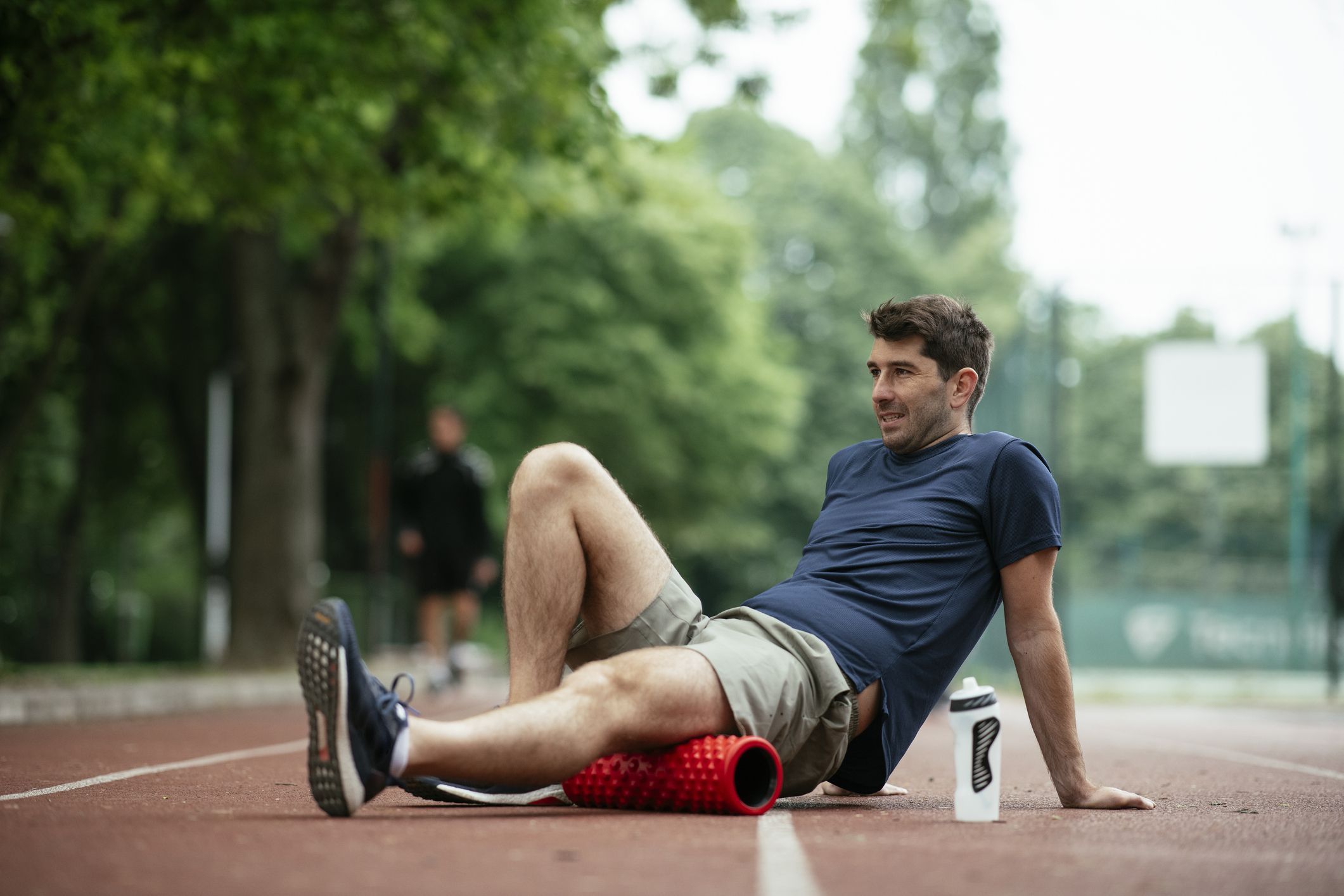Home>Misc>Featured>How To Properly Recover From Distance Running


Featured
How To Properly Recover From Distance Running
Modified: October 24, 2023
Discover the best techniques and tips for properly recovering from distance running in this featured article. Enhance your performance and prevent injuries.
Introduction
Distance running is a popular physical activity that offers a host of physical and mental benefits. Whether you are a seasoned marathon runner or someone who enjoys hitting the pavement for a leisurely jog, it is important to understand the significance of proper recovery after a run. While the act of running itself provides a challenging workout and builds endurance, it is during the recovery phase that the body repairs and strengthens itself, leading to improved performance and overall well-being.
Proper recovery is essential for distance runners to prevent overuse injuries, reduce muscle soreness, and optimize training adaptations. It involves implementing strategies to allow the body to heal and restore itself after the physical stresses endured during a run. Recovery techniques encompass a wide range of practices, including rest, nutrition, hydration, active recovery exercises, and maintaining good sleep habits.
In this article, we will delve into the importance of proper recovery in distance running and explore various strategies and techniques that can aid in the recovery process. Whether you are a beginner or an experienced runner, understanding these principles will help you optimize your training, minimize the risk of injuries, and enhance your overall performance.
The Importance of Proper Recovery in Distance Running
Distance running takes a toll on the body. The repetitive impact and stress placed on the muscles, joints, and cardiovascular system can lead to fatigue, soreness, and increased risk of injuries if not properly managed. This is where the recovery process becomes crucial.
Proper recovery is vital for distance runners as it allows the body to repair and adapt to the demands placed upon it. When you run, microscopic tears occur in your muscles, and it is during the recovery phase that these tears are repaired, ultimately making the muscles stronger and more resilient. Additionally, proper recovery helps replenish glycogen stores, which are essential for providing energy during future runs.
Moreover, recovery plays a pivotal role in injury prevention. Overuse injuries, such as shin splints or stress fractures, often occur when the body is not given enough time to rest and recover between runs. By implementing effective recovery strategies, you can minimize the risk of these injuries and ensure your long-term running success.
Furthermore, proper recovery allows for mental rejuvenation. Running is not just physically demanding; it can also be mentally challenging. Taking the time to recover can help reduce mental fatigue and burnout, allowing you to approach your next run with a fresh mindset and renewed motivation.
Without proper recovery, the body is more prone to experiencing the negative effects of overtraining, such as decreased performance, decreased immune function, and hormonal imbalances. By implementing recovery techniques, you give your body the opportunity to adapt, renew, and strengthen, ultimately leading to improved running performance and overall well-being.
It is important to note that recovery is not a one-size-fits-all concept. Each runner is unique and may require different recovery strategies based on their individual needs and training load. Understanding the importance of proper recovery is the first step towards implementing an effective post-run routine that supports your running goals and keeps you healthy and injury-free.
Understanding the Recovery Process
Recovery is not just a passive process of resting and waiting for the body to heal itself. It is a complex physiological process that involves various mechanisms and adaptations within the body. Understanding how the recovery process works can help you optimize your post-run routine and maximize the benefits of your training.
After a run, the body goes through several stages of recovery. Immediately after exercise, the body undergoes a process called the “acute recovery phase.” During this phase, the body attempts to restore its physiological systems to their pre-exercise state. Heart rate and body temperature gradually decrease, and blood flow shifts from the working muscles back to the internal organs.
Within the first few hours following exercise, it is crucial to replenish the body’s glycogen stores and provide it with the necessary nutrients for recovery. This is known as the “recovery nutrition phase.” Consuming a balanced meal or snack that contains carbohydrates, protein, and healthy fats helps facilitate muscle repair, replenish energy stores, and support overall recovery.
As the acute recovery phase progresses, the body enters the “adaptive phase.” During this stage, the body makes physiological adaptations in response to the stress placed upon it during the run. Muscles rebuild and repair themselves, and the cardiovascular system becomes more efficient.
It is important to note that recovery is not solely limited to the hours immediately following a run. Recovery occurs over a longer time frame, typically spanning several days or even weeks, depending on the intensity and duration of the run. This is known as the “long-term recovery phase.”
During the long-term recovery phase, the body continues to adapt and strengthen. This is when the true benefits of training are realized. It is essential to allow for proper rest and recovery during this phase to avoid overtraining and maximize the training adaptations.
Understanding the different phases of the recovery process is crucial for designing an effective post-run routine. By providing the body with the right nutrition, rest, and time to adapt, you can enhance your recovery and optimize your performance in future runs.
Establishing a Post-Run Routine
A post-run routine is a series of activities and practices that you incorporate into your routine immediately after completing a run. It serves as a crucial component of proper recovery and can significantly impact your overall running performance. By establishing a consistent post-run routine, you can optimize your body’s recovery process and minimize the risk of injuries.
Here are some key elements to consider when establishing your post-run routine:
- Cool Down: After completing a run, it is important to allow your body to gradually return to its resting state. This can be done by incorporating a cooldown session that includes light jogging or walking followed by gentle stretching exercises. Cooling down helps prevent blood from pooling in the muscles and aids in the removal of waste products.
- Hydration: Replenishing lost fluids is crucial for proper recovery. Drink an adequate amount of water or a sports drink to rehydrate your body. Incorporating electrolyte-rich fluids helps restore the balance of essential minerals lost through sweating.
- Nutrition: Refueling your body with the right nutrients is paramount for recovery. Aim to consume a balanced meal or snack within 30 minutes to an hour after your run. Include carbohydrates to replenish glycogen stores, protein to support muscle repair, and healthy fats for overall nourishment.
- Stretching and Mobility Exercises: Engaging in dynamic or static stretching exercises can help improve flexibility, prevent muscle imbalances, and reduce muscle soreness. Focus on stretching the major muscle groups used during your run, paying attention to areas that feel tight or restricted.
- Compression and Cold Therapy: Consider using compression garments or applying cold therapy to specific areas of your body that are prone to soreness or inflammation. Compression helps promote blood flow and reduce swelling, while cold therapy can help numb pain and decrease inflammation.
- Rest and Relaxation: Allow your body ample time to rest and recover between runs. Adequate sleep is essential for physical and mental recovery. Establish a regular sleep routine and aim for 7-9 hours of quality sleep each night.
- Reflect and Track: Take a moment to reflect on your run. Assess how you felt during the run, any discomfort or pain experienced, and areas where you excelled. Tracking your runs and noting any changes or patterns can help you make informed decisions about your training program and recovery strategies.
By incorporating these elements into your post-run routine, you provide your body with the necessary tools to recover and adapt, ultimately enhancing your running performance and overall well-being.
Proper Hydration and Nutrition for Recovery
Hydration and nutrition play a crucial role in the recovery process for distance runners. Properly fueling your body with the right nutrients and maintaining hydration levels is vital for optimizing recovery, preventing muscle fatigue, and supporting overall performance.
Here are some guidelines to follow for proper hydration and nutrition during the recovery phase:
- Hydration: Staying adequately hydrated is essential for optimal recovery. During a run, you lose fluids through sweat, and it is crucial to replace those lost fluids. Aim to drink water or electrolyte-rich fluids before, during, and after your run. The amount of fluid needed varies depending on factors such as temperature, intensity, and duration of your run. Monitor your urine color; if it is pale yellow, you are likely hydrated.
- Recovery Nutrition: Consuming a combination of carbohydrates, protein, and healthy fats after your run is crucial for recovery. Carbohydrates replenish glycogen stores and provide immediate energy, while protein aids in muscle repair and growth. Opt for post-run snacks or meals that contain a mix of these macronutrients. Examples include a fruit and yogurt smoothie, a turkey sandwich with whole-grain bread, or a bowl of oatmeal with nuts and berries.
- Timing: Timing is important when it comes to post-run nutrition. Aim to eat a snack or meal within 30 minutes to an hour after your run to optimize glycogen replenishment and muscle repair. This window of time, known as the “glycogen synthesis window,” is when your body is most efficient at replenishing glycogen stores.
- Protein Intake: As mentioned earlier, protein is crucial for muscle repair and growth. Include a source of lean protein in your post-run meal or snack. Examples of protein-rich foods include chicken, fish, tofu, eggs, or legumes. Aim for a serving size of around 20-30 grams of protein.
- Antioxidant-rich Foods: Incorporate foods rich in antioxidants to combat inflammation and support recovery. Berries, leafy greens, colorful fruits, and vegetables are excellent sources of antioxidants. Including these foods in your post-run meal or snack can help reduce muscle soreness and aid in the recovery process.
- Healthy Fats: Don’t forget to include sources of healthy fats in your recovery nutrition. Foods such as avocados, nuts, seeds, and olive oil provide essential fatty acids that support heart health and aid in nutrient absorption. Including a small portion of healthy fats in your post-run meal helps provide satiety and overall nourishment.
Every runner is unique, and individual nutrition needs may vary. Experiment with different foods and hydration strategies to find what works best for you. Consulting with a registered dietitian who specializes in sports nutrition can also provide personalized guidance to optimize your recovery nutrition plan.
Rest and Sleep: Essential Elements for Recovery
Rest and sleep are two vital components of the recovery process for distance runners. They allow your body to repair, regenerate, and adapt to the physical stressors placed upon it during running. Proper rest and quality sleep are essential for optimizing recovery and performance.
Here are some reasons why rest and sleep are crucial for distance runners:
- Muscle Repair and Growth: During rest and sleep, the body releases growth hormone, which plays a key role in muscle repair and growth. Adequate rest allows the muscles to recover and build strength, helping to prevent overuse injuries and improve performance.
- Energy Restoration: Running depletes glycogen stores, the primary source of energy for endurance exercise. Rest and sleep allow the body to replenish these energy stores, ensuring that you have enough fuel for your next run.
- Hormonal Balance: Rest and sleep are crucial for maintaining hormonal balance. Lack of sleep can disrupt hormone production, potentially leading to increased appetite, decreased muscle recovery, and impaired mental focus.
- Immune System Support: Rest and sleep are essential for a healthy immune system. Sleep deprivation can weaken the immune system, making you more susceptible to illnesses and infections. Prioritizing quality sleep helps keep your immune system functioning at its best.
- Cognitive Function: Rest and sleep play a critical role in cognitive function and mental well-being. A good night’s sleep enhances memory, concentration, decision-making, and overall mental clarity, all of which are crucial for effective training and race performance.
- Stress Reduction: Rest and sleep help reduce stress levels. Running puts stress on the body, and adequate rest allows your body to recover from this physical stress. Additionally, quality sleep helps regulate stress hormones, promoting a sense of calm and balance.
- Injury Prevention: Overtraining and lack of rest can increase the risk of injuries. Regular rest days and sufficient sleep give your body the opportunity to recover and prevent the onset of overuse injuries.
When planning your training schedule, ensure you include regular rest days to allow your body to recover. Aim for 7-9 hours of quality sleep each night, as individual sleep needs may vary. Create a sleep routine that promotes relaxation, such as avoiding electronic devices before bed, keeping a cool and dark sleep environment, and practicing relaxation techniques.
Prioritizing rest and sleep as part of your overall recovery strategy will not only help you optimize your running performance but also improve your overall well-being.
Active Recovery Techniques for Distance Runners
Active recovery is an important aspect of the recovery process for distance runners. It involves engaging in light exercise and movement to enhance blood flow, reduce muscle soreness, and expedite the removal of metabolic waste products. Incorporating active recovery techniques into your routine can help optimize recovery and improve overall running performance.
Here are some effective active recovery techniques for distance runners:
- Low-Impact Cardio: Engage in low-impact cardio exercises such as cycling, swimming, or using an elliptical machine. These activities help increase blood flow to the muscles, promote cardiovascular fitness, and provide a gentle form of exercise without placing additional stress on the joints.
- Walking: Going for a leisurely walk is another excellent active recovery technique. It helps improve blood circulation, aids in muscle recovery, and promotes relaxation. Incorporate walking into your routine on rest days or as a cooldown after a run.
- Yoga or Pilates: Incorporating yoga or Pilates into your recovery routine can help improve flexibility, core strength, and overall body awareness. These low-impact exercises can assist in stretching and lengthening muscles, reducing muscle tension, and improving postural alignment.
- Light Strength Training: Engage in light resistance training exercises to target muscle groups not emphasized during your distance running. Focus on exercises that promote balance, stability, and mobility. This type of training can help strengthen supporting muscles, improve overall body strength, and reduce the risk of imbalances and injuries.
- Massage or Self-Myofascial Release: Schedule regular massages or incorporate self-myofascial release techniques such as foam rolling or using a massage ball. This helps alleviate muscle tension, break up adhesions, and improve blood flow to the muscles, facilitating faster recovery.
- Dynamic Stretching: Dynamic stretching involves controlled movements that take joints and muscles through a full range of motion. Incorporating dynamic stretching exercises into your warm-up or cooldown routine can help improve flexibility, joint mobility, and circulation.
- Cross-Training: Engage in other forms of physical activity or sports that are different from distance running. Cross-training not only provides a break from the repetitive impact of running but also helps strengthen muscles and improve overall fitness. Options include swimming, cycling, rowing, or playing a team sport.
Remember to listen to your body during active recovery. If you feel any pain or discomfort, reduce the intensity or duration of the activity. Active recovery is meant to be gentle and restorative, not exhaustive.
By incorporating these active recovery techniques into your routine, you can enhance your recovery, reduce muscle soreness, and improve overall running performance.
Stretching and Flexibility Exercises for Improved Recovery
Stretching and flexibility exercises are key components of the recovery process for distance runners. They help lengthen tight muscles, improve range of motion, reduce muscle soreness, and prevent injuries. Incorporating stretching and flexibility exercises into your post-run routine can greatly enhance your recovery and overall running performance.
Here are some effective stretching and flexibility exercises to consider:
- Static Stretching: Static stretching involves holding a stretch position for a prolonged period (typically 20-30 seconds). Focus on stretching major muscle groups used while running, such as the quadriceps, hamstrings, calves, and hip flexors. Remember to breathe deeply and relax into each stretch, avoiding bouncing or jerking movements.
- Dynamic Stretching: Dynamic stretching involves moving joints and muscles through a full range of motion in a controlled manner. This type of stretching is particularly beneficial as a warm-up before running. Perform exercises like walking lunges, leg swings, and arm circles to improve joint mobility and warm up the muscles.
- Active Isolated Stretching (AIS): AIS involves targeting a specific muscle group and actively contracting the opposing muscles before stretching it. This technique is effective for increasing flexibility and range of motion. Perform movements such as leg swings, arm circles, or ankle rotations to engage the muscles before stretching.
- Proprioceptive Neuromuscular Facilitation (PNF): PNF stretching involves contracting and relaxing specific muscles while using a partner or a strap for assistance. This stretching technique helps improve flexibility quickly. One popular PNF stretch is the hamstring stretch, where you contract the hamstring muscle, relax, and then stretch it further.
- Yoga: Incorporating yoga into your recovery routine can improve flexibility, balance, and core strength. Yoga poses such as downward-facing dog, runner’s lunge, and pigeon pose can target key muscle groups, release tension, and promote relaxation.
- Foam Rolling: Foam rolling is a form of self-myofascial release that involves using a foam roller to apply pressure to specific muscles to alleviate tightness and improve mobility. Roll slowly over muscles, targeting areas of tension. Focus on major muscle groups such as calves, quadriceps, hamstrings, and IT band.
When performing stretching exercises, it is important to warm up the muscles before deep stretching. Incorporate gentle movements and dynamic stretches to increase blood flow and prepare the muscles for static stretching or deeper flexibility exercises.
Remember to stretch both sides of the body equally and avoid pushing beyond your comfort zone. Stretching should feel challenging but not painful. With regular practice, you can improve your flexibility, prevent muscle imbalances, and enhance your overall recovery and running performance.
Foam Rolling and Self-Massage Techniques
Foam rolling and self-massage techniques are effective ways to target specific muscles, release tension, and alleviate muscle soreness and tightness. These techniques can be incorporated into your post-run routine to enhance recovery and improve overall running performance.
Here are some foam rolling and self-massage techniques to consider:
- Foam Roller: A foam roller is a cylindrical foam tool that can be used to apply pressure to specific muscle groups. Roll slowly over the targeted area, pausing on any tender spots or areas of tension. Focus on major muscle groups used during running, such as calves, quadriceps, hamstrings, IT band, and glutes. Adjust the pressure and angle of the foam roller to find the most effective technique for your body.
- Tennis Ball Massage: A tennis ball or lacrosse ball can be used to apply targeted pressure to specific areas, such as the feet, calf muscles, or glutes. Place the ball under the targeted muscle and apply gentle pressure by leaning onto it. Move the ball around to target different areas. This technique can help release tight muscles and trigger points.
- Self-Massage with Hands: You can also use your hands to apply pressure and massage specific muscles. Use your fingertips, knuckles, or palms to perform gentle kneading or circular motions over areas of tension or tightness. Focus on major muscle groups, working your way from the feet up to the calves, thighs, and glutes.
- Trigger Point Release: Locate trigger points, which are hyperirritable spots in muscles that can refer pain or discomfort to other areas of the body. Apply sustained pressure to these points using your finger, thumb, or a massage tool, until you feel a release or a decrease in discomfort. This technique can help relieve muscle knots and reduce pain.
- Combination Techniques: Experiment with combining different self-massage techniques to create a personalized routine that works best for you. You may find that using a foam roller on larger muscle groups and a smaller tool like a tennis ball for more targeted areas provides optimal results.
When performing foam rolling or self-massage techniques, it is important to start slowly and gradually increase pressure as tolerated. Avoid rolling directly over bones, joints, or areas of acute injury or inflammation. If you experience excessive pain or discomfort, decrease the pressure or consult a healthcare professional.
Incorporating foam rolling and self-massage techniques into your post-run routine can help release muscle tension, increase blood flow, and promote faster recovery. Regular practice of these techniques can lead to improved muscle flexibility, decreased muscle soreness, and enhanced overall running performance.
Cross-Training for Enhanced Recovery
Cross-training is a valuable tool for distance runners to enhance recovery and improve overall running performance. By engaging in other forms of physical activity and exercise, you can give your running muscles a break while still maintaining fitness and promoting recovery.
Here are some benefits of cross-training for distance runners:
- Reduced Impact: Running is a high-impact activity that places repetitive stress on the muscles and joints. Cross-training allows you to engage in low-impact or non-weight-bearing activities that provide a break from the constant pounding of running, giving your body time to recover.
- Muscle Balance: Running predominantly uses certain muscle groups. Cross-training activities, such as swimming, cycling, or strength training, target different muscles and help to maintain balance and strength throughout the body. This helps prevent muscle imbalances and reduces the risk of overuse injuries.
- Improved Cardiovascular Fitness: Cross-training activities that elevate your heart rate, such as swimming or cycling, can help improve cardiovascular fitness without the repetitive impact of running. This allows you to maintain and even enhance your aerobic capacity while giving your running muscles a break.
- Injury Prevention: Cross-training can help prevent running-related injuries by reducing overuse and enabling recovery. By engaging in different activities, you can address any weaknesses or imbalances in your body, promoting overall strength and resilience.
- Mental Refreshment: Cross-training provides a mental break from running while still allowing you to engage in physical activity. This can help prevent burnout, maintain motivation, and provide a new perspective on your training routine.
- Improved Performance: Cross-training can indirectly enhance running performance. By improving overall strength, cardiovascular fitness, and flexibility through cross-training activities, you can become a more well-rounded athlete and potentially improve your running performance.
When incorporating cross-training into your routine, choose activities that complement your running goals and cater to your interests and preferences. Aim for variety by incorporating activities such as swimming, cycling, yoga, Pilates, or strength training. Experiment with different activities to find what works best for you and provides the most enjoyment.
Remember to listen to your body and avoid overdoing it. Avoid cross-training activities that may cause excessive fatigue or impact your running performance. The goal is to use cross-training as a tool to enhance recovery and support your running, not to replace it entirely.
By incorporating cross-training into your routine, you can give your body the rest it needs while still maintaining fitness and promoting optimal recovery, ultimately leading to improved running performance and overall well-being.
Listening to your Body: Recognizing Signs of Overtraining
While consistency is key for distance runners, it is important to listen to your body and recognize the signs of overtraining. Overtraining occurs when the body is subjected to excessive training load without sufficient recovery. Ignoring the warning signs can lead to decreased performance, increased risk of injuries, and overall burnout. By paying attention to your body’s signals, you can make necessary adjustments to your training and recovery routine to prevent overtraining.
Here are some common signs of overtraining to watch out for:
- Chronic Fatigue: Feeling tired and fatigued even after proper rest and sleep can be a sign of overtraining. Persistent exhaustion and decreased energy levels may indicate that your body is not recovering adequately.
- Decreased Performance: If you notice a sudden decline in your running performance, such as slower times or decreased endurance, it may be a sign of overtraining. The body needs sufficient recovery to adapt and get stronger, and pushing too hard can hinder progress.
- Increased Irritability and Mood Swings: Overtraining can impact your mental well-being. If you find yourself feeling irritable, moody, or experiencing a lack of motivation or enjoyment in running, it could be a sign of overtraining. Physical stress can take a toll on your mental state.
- Insomnia and Disrupted Sleep: Overtraining can interfere with your sleep patterns. If you start experiencing trouble falling asleep, staying asleep, or obtaining restful sleep, it may be a sign that your body is under excessive stress.
- Decreased Immune Function: Overtraining weakens the immune system, making you more susceptible to illnesses and infections. If you find yourself getting sick frequently or taking longer to recover from common illnesses, it may be a sign of overtraining.
- Increased Heart Rate and Resting Heart Rate: Monitoring your heart rate can provide valuable insights into your recovery. If you notice an elevated heart rate during rest or an increase in your resting heart rate over time, it may indicate that your body is experiencing excessive stress.
- Persistent Muscle Soreness and Joint Pain: Overtraining can lead to chronic muscle soreness, persistent joint pain, and increased risk of overuse injuries. If you constantly feel achy and experience pain that does not go away with rest, it may be a sign that you need to adjust your training volume or intensity.
If you notice any of these signs, it is important to take a step back and evaluate your training routine. Consider reducing your training volume, incorporating more rest days, or adjusting the intensity of your workouts. Prioritizing recovery, including proper rest, adequate nutrition, and sleep, is crucial for preventing and recovering from overtraining.
Remember, everyone’s body is different, and what works for one person may not work for another. Paying attention to your body’s signals and adjusting your training accordingly is essential for maintaining a healthy and sustainable running routine.
Prevention and Treatment of Common Running Injuries
As a distance runner, it is important to be aware of common running injuries and take proactive steps to prevent and treat them. Running puts repetitive stress on the muscles, tendons, and joints, increasing the risk of injury. By following proper preventative measures and addressing injuries promptly, you can stay on track with your training and minimize downtime.
Here are some key prevention and treatment strategies for common running injuries:
- Gradual Progression: Avoid sudden increases in mileage or intensity. Gradually build up your training volume and allow your body to adapt to the demands of running. This helps prevent overuse injuries caused by pushing your body too hard, too soon.
- Proper Warm-up and Cool-down: Include a dynamic warm-up before your run to prepare your muscles and gradually increase blood flow. After your run, incorporate a cooldown routine that includes stretching and gentle movements to promote muscle relaxation and minimize post-run soreness.
- Strength Training: Strengthening supporting muscles through targeted strength training can help prevent imbalances and reduce the risk of injuries. Focus on exercises that target core stability, hip strength, and leg muscles. Incorporate resistance exercises using bodyweight, resistance bands, or weights.
- Cross-Training: Engage in cross-training activities that complement running, such as swimming, cycling, or yoga. Cross-training helps improve overall fitness, reduces overuse injuries, and gives your running muscles a break.
- Proper Footwear and Biomechanics: Wear proper running shoes that provide adequate support and cushioning for your foot type. Consider getting a gait analysis to identify any biomechanical issues. Orthotic inserts or proper running form may be necessary to prevent injuries caused by overpronation or other imbalances.
- Listen to your Body: Pay attention to any pain, discomfort, or unusual sensations during your runs. If you experience persistent pain or notice any changes in your gait or movement patterns, seek professional advice from a healthcare provider or a sports medicine specialist to address the issue promptly.
- RICE Protocol: If you do experience an injury, follow the RICE protocol: Rest, Ice, Compression, and Elevation. Rest the injured area, apply ice for 15-20 minutes at a time, wrap the area in a compression bandage, and elevate the injured limb to reduce swelling and promote healing.
- Physical Therapy: If an injury persists or worsens, consider seeking the guidance of a physical therapist who specializes in sports-related injuries. They can provide tailored exercises and treatments to address the root cause of the injury and facilitate a safe return to running.
Remember, prevention is key, but if you do experience an injury, early intervention and proper treatment are essential for a swift recovery. Taking steps to prevent injuries and addressing them promptly if they do occur will help you stay on track with your running goals and maintain a healthy and injury-free running routine.
Conclusion
Proper recovery is a crucial aspect of distance running that should not be overlooked. By implementing effective recovery strategies and techniques, you can optimize your performance, reduce the risk of injuries, and enhance your overall well-being as a runner.
From understanding the recovery process to establishing a post-run routine, incorporating proper hydration and nutrition, prioritizing rest and sleep, engaging in active recovery techniques, and paying attention to your body’s signals, each element plays a significant role in the recovery process.
By incorporating stretching and flexibility exercises, utilizing foam rolling and self-massage techniques, considering cross-training activities, and recognizing signs of overtraining and common running injuries, you can take proactive steps to prevent injuries, enhance recovery, and maintain a sustainable running routine.
Remember, every runner is unique, and it’s essential to listen to your body and adjust your training and recovery routines accordingly. By striking a balance between challenging yourself and providing adequate recovery, you can continue to progress and reach your running goals while minimizing the risk of overuse injuries and burnout.
Prioritize your recovery as much as you do your running. Incorporating these strategies into your routine will help you optimize your performance, maximize your potential, and enjoy the many rewards of distance running.









